Stratocaster vs. Telecaster: Key Differences Explained
- The American Guitar Academy

- Oct 4
- 8 min read
When it comes to electric guitars, few names are as iconic as the Fender Stratocaster and Telecaster. These two models have shaped the sound of popular music for decades and are beloved by guitarists around the world for their unique tones and playing experiences. However, despite being created by the same manufacturer, they offer distinctly different qualities. In this article, we’ll dive into the design, tonal qualities, and famous players associated with each guitar to better understand the differences between the Stratocaster and the Telecaster.
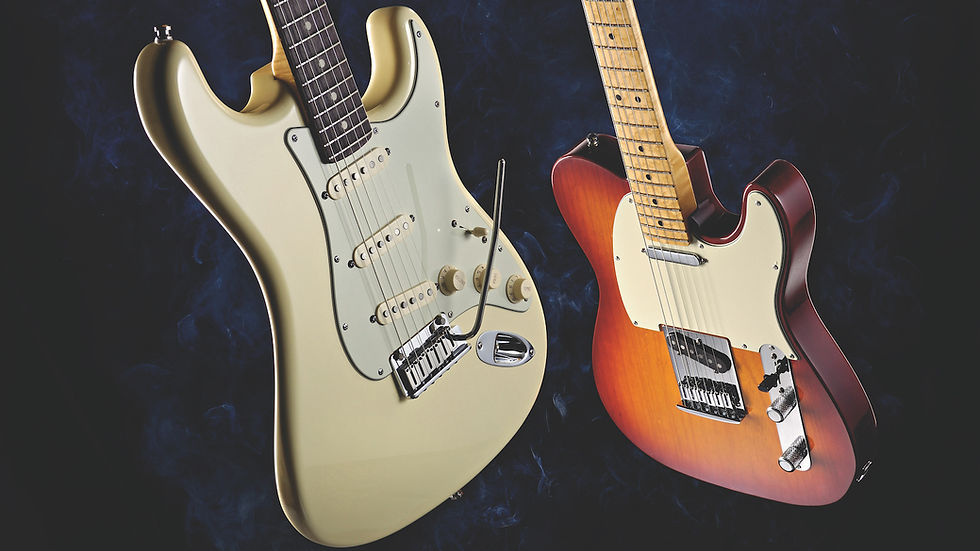
Design Differences
Stratocaster Design
The Stratocaster, commonly known as the "Strat," was introduced by Fender in 1954. It is characterized by its sleek, double-cutaway body, which allows for easier access to higher frets. Key design features include:
Body Shape: The Strat’s contoured, offset body is designed to be comfortable for players, especially when standing.
Pickups: The Strat is typically outfitted with three single-coil pickups, allowing for a wide range of tonal options. The five-way selector switch adds versatility, enabling players to blend pickups for varied sounds.
Tremolo Bridge: A major distinguishing feature is the Strat’s tremolo bridge, which allows for pitch bending. This bridge has made the Strat a favorite among players who like to add vibrato effects to their playing.
Overall, the Stratocaster’s design is versatile, comfortable, and highly customizable, making it popular in various genres.
Telecaster Design
The Telecaster, affectionately known as the "Tele," was introduced in 1951, making it one of the first mass-produced solid-body electric guitars. The Tele's design is iconic for its simplicity and distinct features, including:
Body Shape: Unlike the Strat, the Tele has a single-cutaway, slab-like body with minimal contouring, giving it a distinct, vintage look.
Pickups: The classic Tele has two single-coil pickups, with a three-way selector switch. Its bridge pickup is known for producing a sharp, bright sound, while the neck pickup offers a warmer, rounder tone.
Bridge: The Tele’s fixed bridge design contributes to its solid feel and is believed to enhance sustain and tuning stability.
In terms of design, the Tele is straightforward and built for durability, often described as a "workhorse" guitar perfect for players who favor a more rugged feel and direct tone.
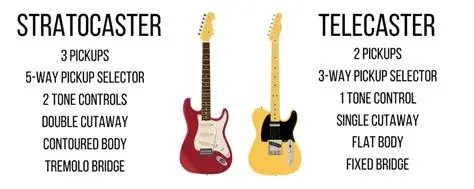
Tonal Qualities
Stratocaster Tone
The Stratocaster is renowned for its bright, bell-like tone and shimmering high-end, which makes it suitable for genres such as rock, blues, pop, and funk. Here are some defining characteristics of the Strat’s tone:
Bright and Articulate: The three single-coil pickups, especially in combination settings, create a “glassy” and bright tone that is well-suited for complex chord voicings and melodic solos.
Versatility: The five-way switch allows players to achieve diverse sounds by blending pickups, producing everything from warm, mellow tones to sharp, punchy highs.
Tremolo Effects: The tremolo bridge allows players to incorporate subtle pitch bending and vibrato effects, giving Strat players a unique expressive capability.
The Strat's tone is often described as cleaner and more delicate compared to the Tele, though it can still achieve powerful sounds when played with overdrive or distortion.
Telecaster Tone
The Telecaster’s tone is often described as bright, twangy, and cutting, with a fuller midrange. This sound has made it a go-to guitar for genres such as country, rock, and blues. Its tonal characteristics include:
Bright and Twangy: The bridge pickup, often paired with a steel plate, creates a sharp, twangy tone that is ideal for country-style “chicken pickin’.”
Warm and Full: The neck pickup of the Tele is warmer and rounder, providing a rich sound that complements jazz and blues styles.
Direct and Raw: The Tele’s fixed bridge contributes to a tone that many describe as raw and punchy. Its simplicity gives it a clear and powerful voice, making it a strong choice for rhythm playing and classic rock sounds.
While the Tele might not have the same tonal versatility as the Strat, its focused, punchy sound gives it a distinct character that is instantly recognizable.
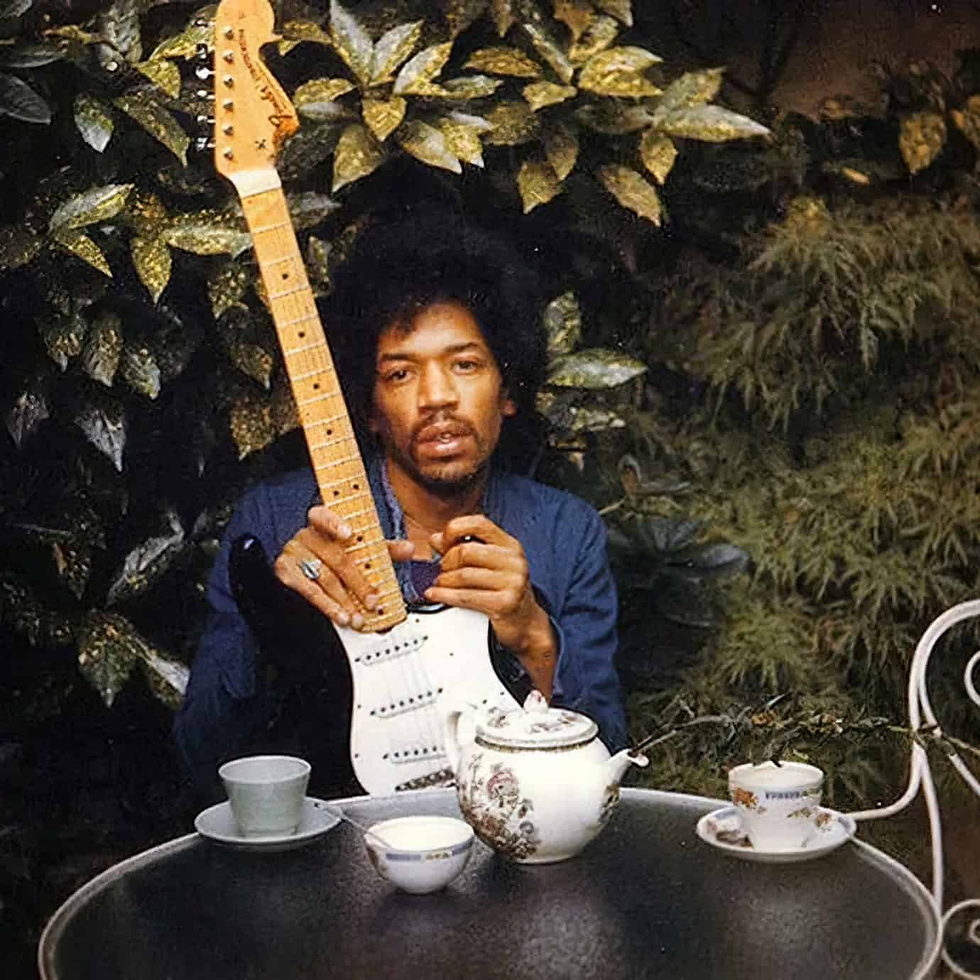
Famous Players
Iconic Stratocaster Players
The Stratocaster has been favored by some of the most influential guitarists in history, thanks to its versatility and expressive qualities. Some notable Strat players include:
Jimi Hendrix: Hendrix’s innovative use of the Strat’s tremolo and his iconic “Hendrix chord” shaped the sound of rock and inspired generations of guitarists.
Eric Clapton: Known for his “woman tone” and blues style, Clapton has used the Stratocaster throughout his career, especially in his solo work.
David Gilmour: Gilmour’s unique blend of soulful playing and delay effects on the Strat helped define Pink Floyd’s sound, particularly in songs like “Comfortably Numb.”
John Mayer: Known for his blues-inspired pop and rock, Mayer has relied on the Strat’s tonal versatility for both rhythm and lead work.
These players exemplify the Strat’s ability to excel across a wide range of genres, from blues and rock to pop and beyond.
Iconic Telecaster Players
The Telecaster also boasts a rich legacy of players known for its distinctive, biting tone and straightforward design. Key Telecaster players include:
Keith Richards: As a member of The Rolling Stones, Richards has been a long-time Telecaster player, using its punchy tone to craft classic rock riffs.
Bruce Springsteen: Known for his gritty, powerful sound, Springsteen’s Tele has been a defining element of his music, symbolizing his raw and energetic style.
Prince: Known for his virtuosity and genre-blending, Prince wielded a custom Tele-style guitar that became a key element of his performances and unique sound.
Brad Paisley: A contemporary country guitarist, Paisley’s “chicken pickin’” and rapid runs showcase the Tele’s classic “twang” in modern country music.
These players highlight the Tele’s ability to cut through the mix with its direct tone, making it popular for rock, country, and punk genres.
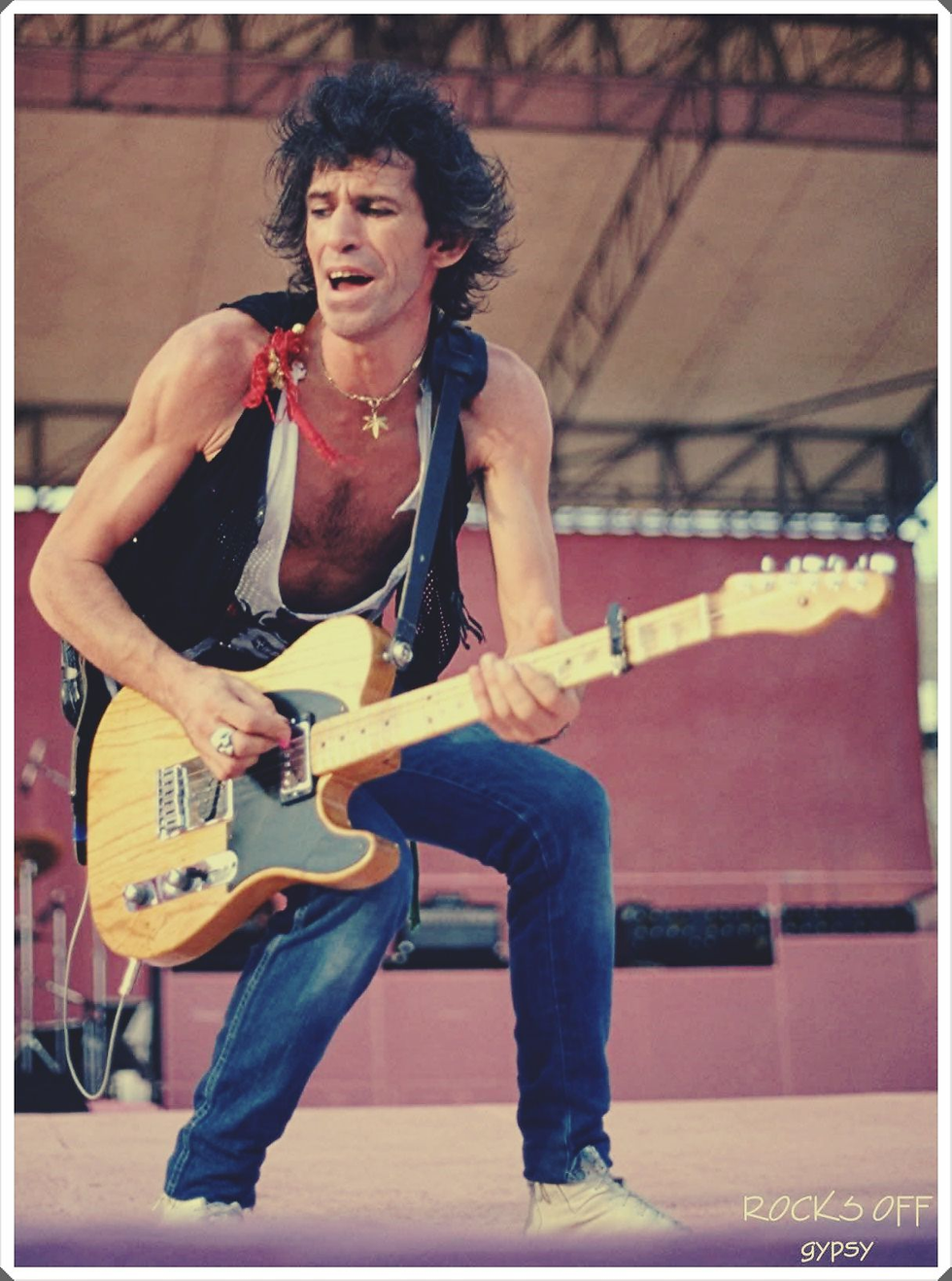
Classic Songs That Exemplify Stratocaster and Telecaster Tones
The unique tones of the Stratocaster and Telecaster have been immortalized in countless classic songs across a range of genres. Here’s a look at some iconic tracks that showcase the distinctive sounds of each guitar.
Songs Featuring the Stratocaster
The Stratocaster’s bright, versatile tone and expressive capabilities have been central to many legendary recordings. Here are some standout tracks that highlight the Strat’s unique sound:
"Little Wing" by Jimi Hendrix – Hendrix’s use of the Strat’s neck pickup delivers the song’s smooth, warm, and ethereal tone. His subtle use of the tremolo arm adds a dreamy quality, exemplifying the Strat’s ability to blend expressive techniques with tonal clarity..
"Comfortably Numb" by Pink Floyd (David Gilmour) – Gilmour’s haunting solos in this track make exceptional use of the Stratocaster’s bridge and neck pickups. His signature sustain and delay effects showcase the guitar’s articulate high end, which soars over the rest of the instrumentation.
"Pride and Joy" by Stevie Ray Vaughan – Vaughan’s aggressive blues playing and his powerful use of the Strat’s middle and neck pickups give this song a sharp, biting tone with just the right amount of warmth. His fast, staccato picking style pairs perfectly with the Strat’s articulate response.
These songs reveal the Stratocaster’s versatility, especially in blues, rock, and psychedelic styles, where players can push its tonal boundaries while still maintaining clarity.
Songs Featuring the Telecaster
The Telecaster’s sharp, twangy sound and direct tone are equally iconic and shine in these classic tracks:
"Born to Run" by Bruce Springsteen – Springsteen’s gritty rhythm playing on this track captures the Telecaster’s raw, punchy sound, cutting through the dense instrumentation with clarity and power. It’s an anthem that exemplifies the Tele’s ability to deliver a driving, unadulterated rock tone.
"Can’t You Hear Me Knocking" by The Rolling Stones (Keith Richards) – Richards’ riff in this song is quintessential Telecaster. The sharp, jangly sound of his rhythm work gives the track its classic rock edge, while the Tele’s clarity keeps every note crisp and powerful, even with a bit of grit.
"Sweet Home Alabama" by Lynyrd Skynyrd – Ed King’s bright, twangy rhythm work and riffs in this Southern rock classic are emblematic of the Tele’s bridge pickup sound. Its cutting tone adds a playful energy to the song that fits the upbeat, Southern vibe perfectly.
"Folsom Prison Blues" by Johnny Cash (Luther Perkins) – Luther Perkins’ “boom-chicka-boom” rhythm style on the Tele defines the classic country sound. The Tele’s sharp attack and twang bring a distinct flavor to this track, adding to the raw and gritty feel of Cash’s music.
These songs capture the Telecaster’s ability to deliver sharp, punchy sounds with a distinct character. Its tone is often described as pure and direct, making it ideal for rock, country, and punk where rhythmic clarity is paramount.
These classic songs demonstrate how the Stratocaster and Telecaster have become embedded in music history, each bringing a unique voice to some of the most memorable recordings of all time. From the shimmering highs of the Strat to the twangy bite of the Tele, these guitars have proven their staying power in the hands of music’s greatest players.
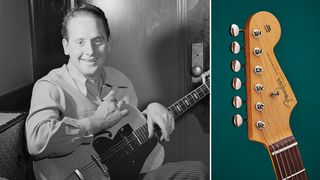
A Brief History of the Stratocaster and Telecaster
The Birth of the Telecaster
The Telecaster, originally named the Broadcaster, was introduced by Fender in 1950 and was the first commercially successful solid-body electric guitar. It was a revolutionary design at the time; before the Telecaster, most electric guitars were hollow-bodied, which often led to feedback issues when amplified. Leo Fender, along with input from musicians, designed a simple, durable guitar with a solid body to avoid these problems, and the result was the single-cutaway Telecaster.
The guitar’s straightforward design – a slab-like body, two single-coil pickups, and a fixed bridge – became an instant hit, particularly with country and blues musicians who loved its sharp, twangy sound. Its simplicity also made it easier to mass-produce, contributing to its success. The Telecaster’s direct tone, combined with its affordability, helped cement its place in the guitar world, and it quickly gained a reputation as a “workhorse” guitar.
The Emergence of the Stratocaster
Building on the success of the Telecaster, Fender sought to create an even more versatile guitar that would appeal to a wider range of players. In 1954, the company unveiled the Stratocaster. Designed by Leo Fender, Freddie Tavares, and George Fullerton, the Stratocaster was a groundbreaking instrument with several notable innovations.
Unlike the Telecaster’s straightforward design, the Stratocaster featured a sleek, contoured double-cutaway body that provided greater comfort for players. It also introduced a third single-coil pickup and a five-way selector switch, allowing for a wider range of tonal options. Perhaps the most revolutionary feature was the addition of the tremolo bridge, which allowed players to add vibrato effects and increased the Strat’s expressive capabilities.
While the Strat was initially slower to catch on, by the 1960s it had become a favorite among rock and blues musicians, gaining popularity through iconic players like Buddy Holly, Jimi Hendrix, and Eric Clapton.
Continued Legacy and Impact
Both the Telecaster and Stratocaster have endured as cultural icons and are still in production today, largely unchanged from their original designs. They continue to be widely used in a variety of genres, from country and rock to funk and pop. Each guitar’s distinct character has not only influenced individual musicians but has also shaped the sound of popular music for over 70 years. The Strat and Tele remain at the heart of Fender’s lineup, standing as symbols of innovation, versatility, and enduring quality in the electric guitar world.
Final Thoughts: Choosing Between the Strat and the Tele
The Stratocaster and Telecaster are both legendary guitars, each with a distinct sound, design, and list of iconic players.
Stratocaster: Best for players seeking a wide range of tones, a comfortable and ergonomic design, and the option for tremolo effects.
Telecaster: Ideal for those who prefer a more direct, punchy sound, simplicity, and durability without the need for extensive tone-shaping options.
Ultimately, both guitars have earned their place in music history, and the choice between them comes down to personal preference, playing style, and genre. Whichever model you choose, both the Strat and the Tele are powerful tools that have proven they can stand the test of time.
-Ryan


